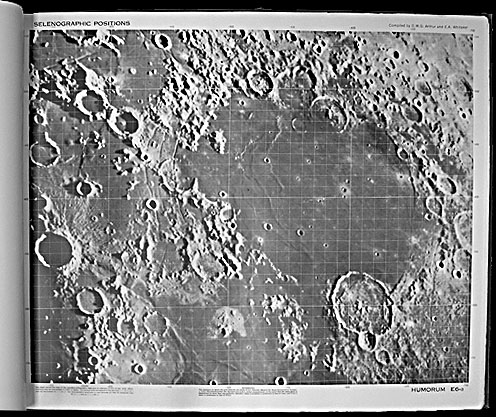Difference between revisions of "April 25, 2004"
| Line 21: | Line 21: | ||
<p class="story" align="left">Gerard Kuiper generated more lunar atlases than any other person I know. In 1959, he began the onslaught with the publication of the <i>Photographic Atlas of the Moon</i>, a heavy red box containing large halftone enlargements of lunar photos. This was followed by the <i>Orthographic Atlas of the Moon</i> (1961), described here, the <i>Rectified Lunar Atlas</i> (1963), and finally the best lunar atlas ever published, the <i>Consolidated Lunar Atlas</i> (1967). These are all long out of print and highly sought collectors' items; I wish I could find my copies! The <i>Orthographic Atlas of the Moon</i>, coauthored with Dai Arthur and Ewen Whitaker, was another large red-covered atlas, bound on the left side with aluminum posts, like some stamp albums. Each page contains a good photograph of an area with a superposed white grid of rectangular coordinates, xi and eta. This is the same coordinate system used on the <i>Lunar Quadrant Maps</i> sold by <i>Sky & Telescope</i>. The orthographic coordinate grid made it easy - and still does - to determine the coordinates of a feature, for example, the position of a shadow-casting peak. Forty years ago, I used the <i>Ortho Atlas</i> every day in compiling the <i>System of Lunar Craters</i> catalog and maps.</p> | <p class="story" align="left">Gerard Kuiper generated more lunar atlases than any other person I know. In 1959, he began the onslaught with the publication of the <i>Photographic Atlas of the Moon</i>, a heavy red box containing large halftone enlargements of lunar photos. This was followed by the <i>Orthographic Atlas of the Moon</i> (1961), described here, the <i>Rectified Lunar Atlas</i> (1963), and finally the best lunar atlas ever published, the <i>Consolidated Lunar Atlas</i> (1967). These are all long out of print and highly sought collectors' items; I wish I could find my copies! The <i>Orthographic Atlas of the Moon</i>, coauthored with Dai Arthur and Ewen Whitaker, was another large red-covered atlas, bound on the left side with aluminum posts, like some stamp albums. Each page contains a good photograph of an area with a superposed white grid of rectangular coordinates, xi and eta. This is the same coordinate system used on the <i>Lunar Quadrant Maps</i> sold by <i>Sky & Telescope</i>. The orthographic coordinate grid made it easy - and still does - to determine the coordinates of a feature, for example, the position of a shadow-casting peak. Forty years ago, I used the <i>Ortho Atlas</i> every day in compiling the <i>System of Lunar Craters</i> catalog and maps.</p> | ||
<p class="story"><b>Related Links:</b><br>[http://quest.arc.nasa.gov/lfs/kuiper-bio.html Gerard P. Kuiper]</p> | <p class="story"><b>Related Links:</b><br>[http://quest.arc.nasa.gov/lfs/kuiper-bio.html Gerard P. Kuiper]</p> | ||
| − | <p class="story">The system of lunar craters, quadrant I</i>: Arthur, DWG, Agnieray, AP, Horvath, RA, Wood, CA, and Chapman, CR, 1963, Communications of the Lunar and Planetary Laboratory, v. 2, no. 30, p. 71-78, 4 appendixes and 12 maps.</p> | + | <p class="story"><i>The system of lunar craters, quadrant I</i>: Arthur, DWG, Agnieray, AP, Horvath, RA, Wood, CA, and Chapman, CR, 1963, Communications of the Lunar and Planetary Laboratory, v. 2, no. 30, p. 71-78, 4 appendixes and 12 maps.</p> |
<p><b>Yesterday's LPOD:</b> [[April 24, 2004|The Star of Astronomy Night]] </p> | <p><b>Yesterday's LPOD:</b> [[April 24, 2004|The Star of Astronomy Night]] </p> | ||
<p><b>Tomorrow's LPOD:</b> [[April 26, 2004|America Hits the Moon!]] </p> | <p><b>Tomorrow's LPOD:</b> [[April 26, 2004|America Hits the Moon!]] </p> | ||
Revision as of 14:45, 1 February 2015
Ortho Atlas
Image Credit: Lunar & Planetary Lab, Univ. of Arizona; photo by CA Wood |
|
Ortho Atlas Gerard Kuiper generated more lunar atlases than any other person I know. In 1959, he began the onslaught with the publication of the Photographic Atlas of the Moon, a heavy red box containing large halftone enlargements of lunar photos. This was followed by the Orthographic Atlas of the Moon (1961), described here, the Rectified Lunar Atlas (1963), and finally the best lunar atlas ever published, the Consolidated Lunar Atlas (1967). These are all long out of print and highly sought collectors' items; I wish I could find my copies! The Orthographic Atlas of the Moon, coauthored with Dai Arthur and Ewen Whitaker, was another large red-covered atlas, bound on the left side with aluminum posts, like some stamp albums. Each page contains a good photograph of an area with a superposed white grid of rectangular coordinates, xi and eta. This is the same coordinate system used on the Lunar Quadrant Maps sold by Sky & Telescope. The orthographic coordinate grid made it easy - and still does - to determine the coordinates of a feature, for example, the position of a shadow-casting peak. Forty years ago, I used the Ortho Atlas every day in compiling the System of Lunar Craters catalog and maps. Related Links: The system of lunar craters, quadrant I: Arthur, DWG, Agnieray, AP, Horvath, RA, Wood, CA, and Chapman, CR, 1963, Communications of the Lunar and Planetary Laboratory, v. 2, no. 30, p. 71-78, 4 appendixes and 12 maps. Yesterday's LPOD: The Star of Astronomy Night Tomorrow's LPOD: America Hits the Moon! |
Author & Editor:
Charles A. Wood
COMMENTS?
Register, and click on the Discussion tab at the top of the page.
Contributions to http://www2.lpod.org/ are licensed under a Creative Commons Attribution No-Derivative-Works Non-Commercial 3.0 License. 




